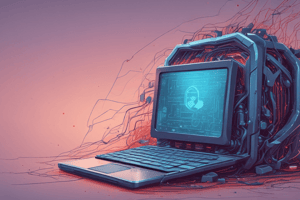Podcast
Questions and Answers
In the context of cybersecurity, what does 'vulnerability' refer to?
In the context of cybersecurity, what does 'vulnerability' refer to?
- An individual who gains unauthorized access to data or systems.
- A type of malware that replicates itself to spread to other computers.
- A security system that controls incoming and outgoing network traffic.
- A weakness in a system that can be exploited by a threat. (correct)
Why is cybersecurity important for individuals and organizations?
Why is cybersecurity important for individuals and organizations?
- It is solely needed for governments to protect their infrastructure and citizens.
- It primarily focuses on optimizing network performance and reducing hardware costs.
- It helps in developing new software applications and improving customer service.
- It prevents identity theft and protects financial information, ensuring safe online activities. (correct)
What is the primary function of a 'firewall' in cybersecurity?
What is the primary function of a 'firewall' in cybersecurity?
- To control incoming and outgoing network traffic based on security rules. (correct)
- To encrypt sensitive data and prevent unauthorized access.
- To detect and remove malicious software from a system.
- To provide an extra layer of security using two forms of identification.
Which role in cybersecurity involves testing systems to find vulnerabilities?
Which role in cybersecurity involves testing systems to find vulnerabilities?
What is the purpose of Two-Factor Authentication (2FA)?
What is the purpose of Two-Factor Authentication (2FA)?
In the context of network components, what is the role of a 'router'?
In the context of network components, what is the role of a 'router'?
How does a 'switch' differ from a 'hub' in a network?
How does a 'switch' differ from a 'hub' in a network?
Which network component is responsible for storing files, managing access, and running applications for other computers?
Which network component is responsible for storing files, managing access, and running applications for other computers?
What does 'network topology' refer to?
What does 'network topology' refer to?
Which of the following is a common type of network topology?
Which of the following is a common type of network topology?
Flashcards
What is Cybersecurity?
What is Cybersecurity?
Reducing the risk and impact of cyberattacks for organizations or individuals.
Threat
Threat
Anything that can cause harm to your system or data (e.g., hackers, viruses).
Vulnerability
Vulnerability
A weakness in a system that can be exploited.
Malware
Malware
Signup and view all the flashcards
Phishing
Phishing
Signup and view all the flashcards
Firewall
Firewall
Signup and view all the flashcards
Two-Factor Authentication (2FA)
Two-Factor Authentication (2FA)
Signup and view all the flashcards
What is a Network?
What is a Network?
Signup and view all the flashcards
Router
Router
Signup and view all the flashcards
Switch
Switch
Signup and view all the flashcards
Study Notes
- Cybersecurity reduces the risk and impact of cyberattacks for organizations or individuals.
Key Terms in Cybersecurity
- Threat: Anything that can cause harm to systems or data (e.g., hackers, viruses).
- Vulnerability: A weakness in a system that can be exploited.
- Malware: Malicious software like viruses, ransomware, or spyware.
- Phishing: An attack using fake emails or websites to trick people into giving out information.
- Firewall: A security system controlling incoming and outgoing network traffic.
- Two-Factor Authentication (2FA): Security that uses two forms of identification to access an account.
- Antivirus Software: Programs that detect and remove malicious software.
- Hacker: Someone gaining unauthorized access to data or systems.
- Patch: A software update designed to fix bugs or vulnerabilities.
Need for Cybersecurity
- Protects personal data like passwords and bank information from hackers.
- Prevents identity theft by cybercriminals.
- Keeps businesses safe by protecting financial and customer data.
- Supports national security by protecting government infrastructure and citizens.
- Ensures safe online activity for browsing, shopping, and communication.
Roles in Cybersecurity
- Security Analyst
- Security Engineer
- Penetration Tester (Ethical Hacker)
- Forensic Analyst
- Chief Information Security Officer (CISO)
- Network Security Engineer
- Government Risk Compliance
What is a Network
- A network includes two or more computers or devices (phones, printers, servers) connected to share data and communicate.
Components of a Network
- Router: Directs traffic between devices and connects a network to the internet.
- Switch: Connects multiple devices inside a local network to help them communicate.
- Hub: Connects multiple computers in a network, but sends data to all devices (less secure than switches).
- Network Cable (Ethernet): Physical cables that connect devices in wired networks.
- Server: A powerful computer that stores files, manages access, or runs applications for other computers on the network.
Network Topology
- Network topology is the layout of how a network communicates with different devices
Types of Topology
- Star Topology
- Bus Topology
- Ring Topology
- Mesh Topology
- Hybrid Topology
- Point to Point
- Point to multipoint
Studying That Suits You
Use AI to generate personalized quizzes and flashcards to suit your learning preferences.




